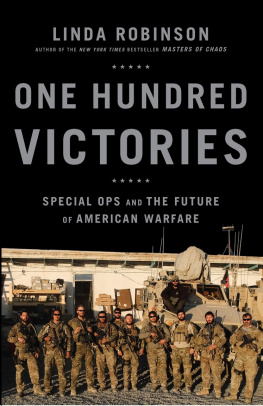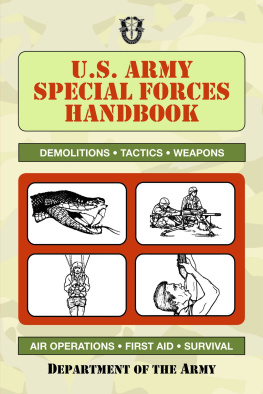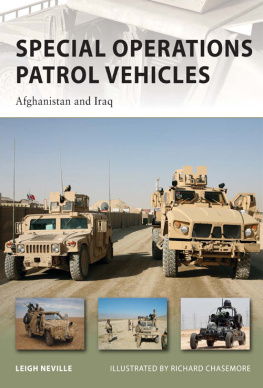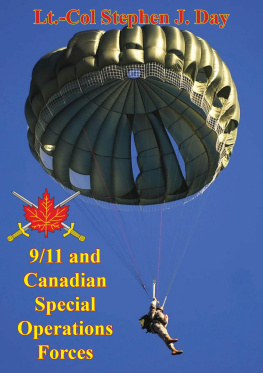
ALSO BY LINDA ROBINSON
Tell Me How This Ends:
General David Petraeus and the
Search for a Way Out of Iraq
Masters of Chaos:
The Secret History of the Special Forces

"To win one hundred vistories in one hundred battles is not the acme of skill. To subdue the enemy without fighting is the acme of skill."
SUN TZU
TABLE OF CONTENTS
CAST OF CHARACTERS
(Listed in order of appearance. Military ranks are current as of July 2013.)
INTRODUCTION
Maj. Gen. Christopher Haas CFSOCC-A commander, 20112012
Bismullah Khan Mohammedi Tajik leader, minister of interior, minister of defense
Col. Mark Schwartz CJSOTF-A commander 20112012
CHAPTER 1: HITTING TARGETS
Maj. Gen. Edward Reeder CFSOCC-A commander, 20092010
Lt. Col. Brad Moses CJSOTF-A operations officer
Col. Pat Mahaney battalion and deputy CFSOCC-A commander
Maj. Christopher Castelli company commander
CHAPTER 2: INTO THE VILLAGES
Maj. Gen. Scott Miller CFSOCC-A commander, 20102011
Command Sgt. Maj. J. R. Stigall CFSOCC-A command sergeant major
Capt. Geno Paluso (Navy) CFSOCC-A chief of staff
Brig. Gen. Don Bolduc CJSOTF-A and deputy SOJTF-A commander
CHAPTER 3: THE TALIBANS HOME
Col. Chris Riga Special Operations Task Force South commander, 20102011
Brig. Gen. Abdul Raziq Afghan police general in Kandahar
CPT Dan Hayes and ODA 3314 team in Maiwand, 20102011
Jan Mohammed Afghan Local Police commander in Maiwand
Maj. Scott White company commander at Camp Simmons
Col. Bill Carty Special Operations Task Force South commander, 20112012
CHAPTER 4: PAKTIKA
Maj. Mike Hutchinson and ODA 3325 team in Paktika, 20102011
Commander Aziz Afghan Special Squad leader in Paktika
CHAPTER 5: ON THE BORDER
Cpt. Matt and ODA 3316 team in Kunar, 2011
Nur Mohammed Afghan Local Police commander in Kunar
Maj. Eddie Jimenez company commander at Camp Dyer
Lt. Col. Bob Wilson Special Operations Task Force East commander, 20112012
CW2 Mike and ODA 3313 American team partnered with Afghan 1st Commando Kandak
CHAPTER 6: THE BURDENS OF COMMAND
Gen. John AllenISAF commander
Col. Heinz Dinter CFSOCC-A operations officer, 20112012
Capt. Wes Spence (Navy) CFSOCC-A chief of staff, 20112012
Cdr. Alec McKenzie CFSOCC-A staff officer in charge of ALP program
CHAPTER 7: ON THE SAME TEAM OR NOT
CPT Brad Hansell and ODA 7233 team in Maiwand, 2012
Captain Najibullah Afghan Special Forces team leader
Lt. Col. Richard Navarro Special Operations Task Force South commander, 2012
Command Sgt. Maj. Brian Rarey SOTF-S battalion sergeant major
Maj. Angel Martinez company commander at Camp Simmons
Sgt. Maj. J. R. Jones company sergeant major at Camp Simmons
CHAPTER 8: SEALS DO FOREIGN INTERNAL DEFENSE, TOO
Cdr. J.R. Anderson Special Operations Task Force Southeast commander, 2011
Commander Mike Hayes Special Operations Task Force Southeast commander, 2012
Abdul Samad Taliban leader
Lt. Marshall SEAL platoon leader partnered with Afghan 8th Commando Kandak
Lt. Col. Ahmadullah Popal 8th Commando Kandak commander
CHAPTER 9: GOOD ENOUGH?
CPT Jason Russell and ODA 1114 team in Paktika, 20122013
CPT Jae Kim and ODA 1411 team in Paktika, 20122013
CHAPTER 10: HIGHWAY ONE
CPT Terrence Jackson and ODA 1326 team in Ghazni
Lt. Col. Chris Fox Special Operations Task Force East commander, 20122013
Maj. John Bishop SOTF-E operations officer
CHAPTER 11: WILL THE VALLEY HOLD?
Maj. Kent Solheim company commander at Camp Dyer
ODA 3131 team in Kunar, 20122013
Asim Gul, Wazir and Gudjer ALP commanders in Kunar
Maj. Ben Hauser company commander at Camp Dyer
Col. Tony Fletcher CJSOTF-A commander, 20122013
CHAPTER 12: THE ENDGAME
Maj. Gen. Tony Thomas SOJTF-A commander, 20122013
Brig. Gen. Sean Swindell NATO Training Mission-Afghanistan deputy commander
Gen. Sher Mohammed Karimi chief of Afghan army general staff
INTRODUCTION
YOULL HAVE TO KILL
A LOT OF MEN LIKE MY FATHER
Chris Haas was one of the first Americans to arrive in Afghanistan after the 9/11 attacks on New York and Washington. A shaved-bald special forces officer with a hoarse voice and a love of cigars, Haas is easygoing but essentially private, careful and skeptical while maintaining an outward affability. He bowed his head before each meal, but did not speak of religion. His reserve contrasted with the effusive warmth of his Texan wife, Betty, whose smiling picture he tacked to the bulletin board by his desk.
Haas flew in on October 26, 2001, on one of the first helicopters that made it over the Hindu Kush following 9/11. At the time he was a lieutenant colonel, and he would be in command of the first four special forces teams to soldier through the winter weather and link up with Northern Alliance militia leaders. He would work side by side with CIA veterans of the Afghan-Soviet war of the 1980s, who would r.5eforge their ties with the Northern Alliance, dispensing suitcases of cash for Afghan salaries, equipment, and fuel. The three who arrived first were Agency pros and a pleasure to work with, qualities not shared by some of the whippersnappers the CIA would later send out. They included Doc, who had been a special forces medic before joining the CIA; Gary Schroen, a former field officer; and Gary Berntsen, a former CIA station chief.
Haass most important duty was serving as liaison to the Northern Alliance leadership, the Tajik-led militia that had been fighting the Taliban for years and was the only armed group with the ability to topple the regime and oust its Al Qaeda allies. The G chief, or guerrilla leader, was Bismullah Khan Mohammedi, a wily, determined Northern Alliance leader who was highly beholden to his Tajik faction, the second largest of the groups making up Afghanistans ethnic mosaic. As he grilled Haas in his headquarters at Jabal Saraj, he sought to put his would-be patron on the defensive. Are you ready to lose men? There will be fighting, he said to Haas and his operations officer, Mark Schwartz. Is the United States going to abandon us again? he continued, referring to the abrupt end of Americas interest in Afghanistan after the Soviet departure in 1989. Haas knew it was a test. Bismullah Khanor BK, as he would come to be known in the years ahead, when he went on to become Afghanistans army chief of staff, interior minister, and then defense ministerwas trying to level the playing field. The Northern Alliance certainly wanted American help, and it desperately needed the firepower that Haas had at his disposal. But BK wanted to stay in the drivers seat. The Northern Alliance wanted American help in order to throw out the Taliban and take control of the country.
From his training, Haas knew that managing this relationship was crucial. He could not change BK or his groups objectives, but he could not become captive to them either. Over the weeks and months ahead, he and BK became friendly, but Haas never gave in. Haas would call him on that righteous talk, Schwartz later recalled. He would talk to him straight.
The basic objectivetoppling the Taliban and getting Osama bin Ladenwas clear, but the details were complex. Haas was to strengthen the Northern Alliance militia while simultaneously restraining it from sweeping south to capture Kabul, Afghanistans capital, and wreaking vengeance on the Pashtunswho formed the largest of Afghanistans ethnic groups. He was to stall the alliance until a multiethnic power-sharing agreement had been forged in Bonn and a leader had been chosen. Meanwhile, he was to keep tabs on feuds among the various militia leaders of the north as well as among the Pashtun factions jockeying for control over Kandahar, the second largest city in the country after Kabul.
Next page









